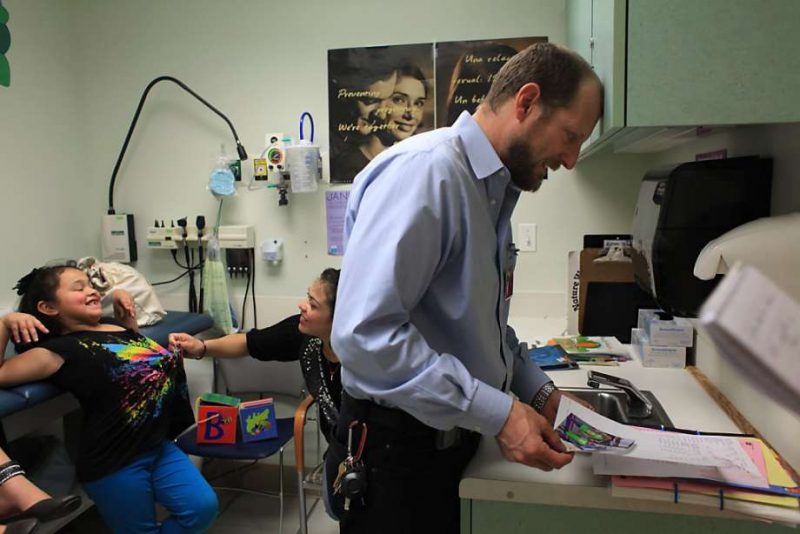Dr. Robert Savio gave 10-year-old Yazmin Peña and her 7-year-old sister, Esmeralda, high-fives as he shared results of the girls’ test results from a pilot project on pediatric obesity at Alameda County’s Highland General Hospital in Oakland.
Yazmin’s triglycerides, a type of fat found in the blood, had dropped more than 25 percent and her sister’s fell by about 17 percent in the eight months since the family joined the program.
“You both went down the most in triglycerides, and they’re the most damaging for your heart,” explained Savio, Highland’s chief of pediatrics, who helped develop the campaign to improve the eating habits of his patients, especially among ethnic groups that have the highest rates of obesity.
The Peña family of Oakland was among 15 families who participated in the hospital’s six-month healthy eating project.
Unlike other programs, in which health care providers urge patients to eat better, Highland actually provides healthy food. In so-called “grub boxes” from West Oakland’s People’s Grocery, each family every week received a bag of fresh fruits and vegetables.
The project, which ended in November, also tracked the children’s health and required families to attend monthly meetings to teach them about nutrition and how to prepare the foods.
Obesity a requirement
In each family, at least one child had to meet the technical definition of obesity. That meant having a body mass index, or BMI, which assesses weight relative to height, in the 95th percentile or higher.
Children in low-income families, particularly Latinos and African Americans, have higher-than-average rates of obesity that, in young people, can lead to a raft of health problems including many that persist into adulthood. Diabetes and cardiovascular disease are among the most common ailments.
“We see a disproportionate number of families that are struggling with pediatric obesity,” said Savio’s colleague, Michele Bunker-Alberts, a family nurse practitioner and lactation consultant. “They typically live in neighborhoods where they have less access to the type of foods we’re asking them to eat.”
Additional barriers to healthy eating include easy access to cheap junk foods, financial constraints, transportation problems, lack of time to prepare food and family habits.
Bunker-Alberts designed the project with help from the American Academy of Nurse Practitioners, which provided $10,000 in grants.
To begin, Highland’s pediatric providers measured the children’s weight and other indicators of their health, such as cholesterol and glucose levels. Savio and Bunker-Alberts stressed that with children, the goal is typically not to reduce weight but to focus on maintaining it so that when the child grows, his or her BMI will drop.
Learning about foods
Bunker-Alberts said families often considered foods like yogurt and juices to be healthy, without considering some of the less healthy aspects like sugar levels and calories. And many of the families didn’t know what to do with some of the foods in their bags.
Raheemah Nitoto, a holistic health and nutrition educator who ran the workshops with a hospital nutritionist, said some of the participants weren’t able to recognize leafy green vegetables such a chard or kale.
“So handing them that and telling them to go off and eat that wouldn’t be helpful,” she said.
That’s where the workshops came in. There the families learned how to prepare vegetables like chard and kale and often shared information with each other. The workshops also focused on such issues as portion control and how to read food labels, she said.
Esperanza Peña, mother of Yazmin and Esmeralda, whose test results had improved, lost 50 pounds herself over the course of the project.
She said she was surprised to learn that eating together each night as a family – without television or other distractions – could have an impact on weight and health. She said she increased the amount of exercise for the whole family and continues to buy the healthy foods her daughters had a fondness for.
They include foods like broccoli, carrots, corn, mushrooms, lettuce, peaches – but not eggplant. Both girls said they had to adjust to the smaller portions, missed certain foods and didn’t embrace every new vegetable.
Increased energy
“I felt like I was eating only grass,” Esmeralda said of her initial reaction.
But both sisters said their energy has increased and they felt good about participating. “They’re teaching us how we can get healthy,” Yazmin said.
Savio and Bunkers-Albert are still collecting data from the project. But they hope to expand it to more patients and their families.
Ultimately their goal is to track patients for years to see if jump-starting new eating habits by providing them with healthy foods made a long-term difference in their lives.
“It would be really interesting to see, did any of this stick?” Savio said.
Edited on June 11, 2018.


